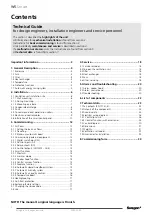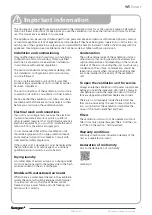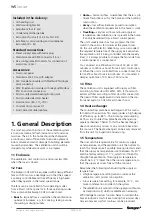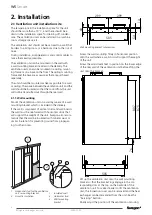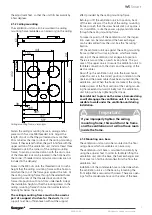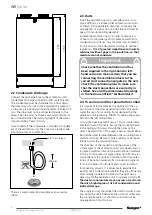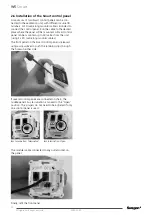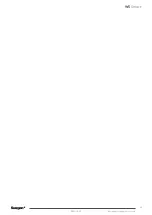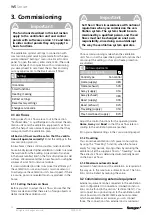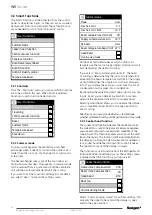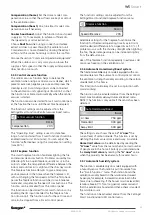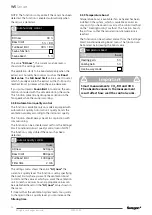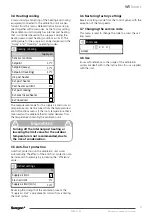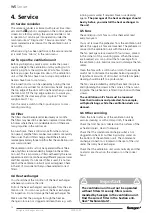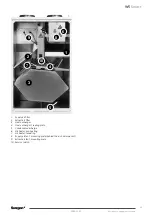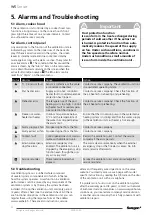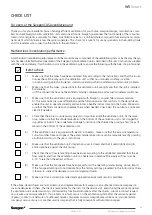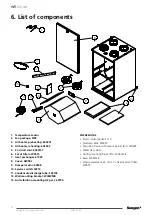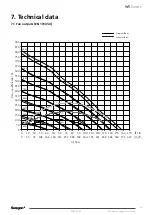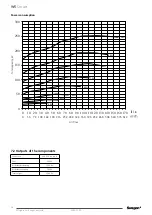
9
W5
Smart
All rights to changes reserved.
2020-11-19
2.5 Electric and control cables
A 1.5 m long cable with earthed plug-in contact is fitted
to the ventilation unit for measuring the voltage. The
cable extends from the top of the unit. The mains plug
serves as the ventilation unit’s main switch and it should
be connected to an electric socket at an easily acces-
sible spot. For power required, see the Section entitled:
“Technical data”.
There is an earthing point on the top surface of the
ventilation unit body.
On top of the ventilation unit are two modular cables for
control of the unit. The maximum connected length of the
modular cable in the system is 40 metres. If you lengthen
the modular cable within some building element (e.g. in
a wall), you should lengthen the cable in a
∅
20 mm con-
duit, anticipating a possible later change of cabling.
When installing the unit, make sure that you provide
adequate access to the cable connector, e.g. for servic-
ing and adjusting the unit, if and when the need arises.
In multi-storey buildings, a control panel can be used as
a so-called hand-held micro terminal in conjunction with
service and installation work.
Any accessories are either connected to the ventilation
unit’s four-way connector (2 optional functions) or to
the external connection modules (3 optional functions).
Cables are routed via the lead-through openings in the
top of the ventilation unit. The connection of any acces-
sories is described in the section “External connections”.
Cables to connection modules and accessories are not
included in the supply.
In general, ventilation ducts should be insulated in the
following manner:
• Insulate outdoor air ducts run through warm spaces.
• Exhaust air ducts should always be insulated in ac-
cordance with national regulations. See separate pro-
ject planning instructions (for example Fire resistance
classification requirements).
• Insulate supply air ducts in cold spaces.
• Insulate extract air ducts in cold spaces.
• If the air inside the duct is colder than in the sur-
roundings; the insulation should be protected by a
vapour barrier.
Important
Even small gaps in the insulation impair the
sound attenuation and bring about a risk of
condensation and consequential damages.
!
!
Important
Before commissioning the ventilation sys-
tem, check that the ventilation unit, filters,
condensation drain and ducts are clean and
that there are no loose objects inside them.
The ventilation ducts should be cleaned
regularly and always when the home is
renovated.
!
!
Important
It is absolutely forbidden to operate the
ventilation system during the construction
period or if dust-raising work is carried out.
Before installing the unit, the ducts should
be blanked off with covers to prevent the
entry of impurities.
!
!
Important
If any further electrical wiring is required,
only a qualified electrician shall be allowed
to carry out this work.
The electric and control cables are located
on the upper side of the ventilation unit.
Make sure that the electric cable can be con-
nected to a wall outlet without obstruction.
!
!
A. Equipment box cover
B. Cable entry for any accessories
C. Terminal blocks for connection of accessories
NOTE! The cables must be directed, from the
terminal blocks, towards the rear of the unit.
A
B
C


